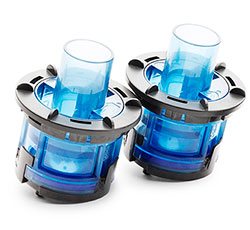Disease groups, which can be treated by mechanical ventilation, either via tracheotomy or non-invasively, can be divided into:
- Neuromuscular
- Anatomical defects
- Pulmonary disease
Still in keeping with health care structures and budgets, the effort required to deal effectively with these patients has created a need for a wide range of locations, ranging from the hospital to the home. Discharge planning is essential in order to ensure a smooth transition and continued care, including technical support, once the patient is home. Health education should play a key role so that the chronically ill patient can learn to maximise their potential1 and be aware of their own responsibilities during their treatment.
Trends within Mechanical Ventilation
Depending upon their condition or disease state the patient may have been in the Intensive Care Unit (ICU), then moved to the High Dependency Unit (HDU) or Respiratory Care unit for weaning and stabilisation purposes. Patients who are stable but who do not have the option of placement outside the Hospital, or who are terminally ill, often stay in the General med/surgical ward. The trend in mechanical ventilation is towards treating the patient non-invasively and providing mechanical ventilation more pro-actively for the paediatric and chronically obstructed or restricted patient for their future improved outcomes.
The number of patients receiving mechanical ventilation both in the home and at sites outside the acute care hospital is increasing. Long-term care may be provided via skilled nursing facilities and living-in centres/clinics for patients whose disease states are too far advanced or who are suffering weaning difficulties. Patients in all groups have improved survivals and quality of life when ventilator assisted (VAI) or treated with long-term mechanical ventilation (LTMV). Patients with restrictive thoracic disorders consistently have an improvement in symptoms of chronic hypoventilation and better quality of sleep after starting ventilatory assistance. In a survey by A.K. Simonds et al 2000, 73% of the patients had less fatigue, 44% less breathlessness and 48% decreased frequency of respiratory infections. The majority of patients were able to return to work at home and some returned to professional work.
1. Brown S, Mann R. Profess Nurse 1990; 3 : 325-8
2.Thorax 1995: 50:604-609
The World Health Organisation, WHO, estimated that in the year 2000, 2.74 million deaths were caused by COPD, chronic obstructive pulmonary disease. In 1990 it was ranked 12th as a burden of disease, by 2020 it is projected to rank 5th. Loosening and removal of secretions in the airways accelerates blood-gas exchange in the oxygen starved COPD patient, helps to prevent pulmonary infections, improves ventilation and decreases the need for invasive mechanical ventilation. (Bach J, CHEST 1998:112 1024-1028 CHEST 1993: 104 : 1553-1562)
For all patient types, whether long-term ventilation, weaning, non-invasive respiratory support or ventilation therapy, safety, comfort, control and ease of use are paramount for the patient. Vivo has the solution to their needs, please view the Vivo Products & Solutions and contact us for more information.
 With ever increasing demands on Health Care budgets worldwide, several trends have emerged in the long term mechanical ventilation area (LTMV). Technological advances in mechanical ventilation have enabled medical practitioners to support patients for longer periods of time who suffer from chronic respiratory disorders. In the last decade more patients are being sent home earlier from hospital. There is an increase in the pro-active application of mechanical ventilation of COPD and paediatric patients.
With ever increasing demands on Health Care budgets worldwide, several trends have emerged in the long term mechanical ventilation area (LTMV). Technological advances in mechanical ventilation have enabled medical practitioners to support patients for longer periods of time who suffer from chronic respiratory disorders. In the last decade more patients are being sent home earlier from hospital. There is an increase in the pro-active application of mechanical ventilation of COPD and paediatric patients.
